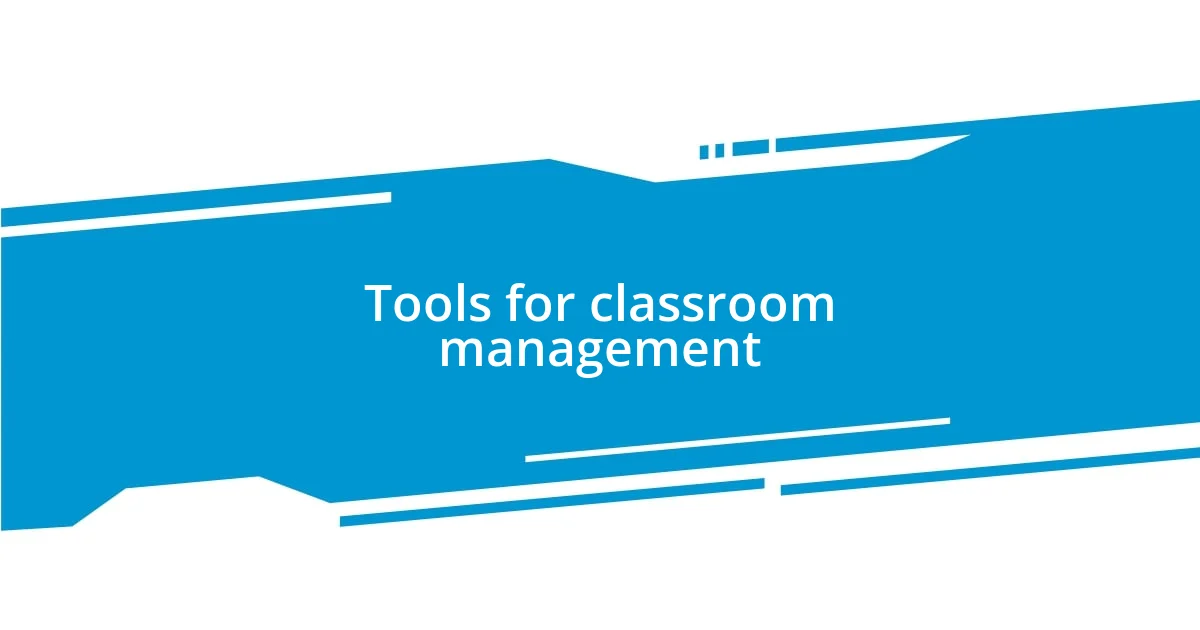Key takeaways:
- Setting clear expectations and rules from the first day fosters a secure and engaging classroom environment.
- Implementing positive reinforcement and acknowledging individual efforts significantly boosts student confidence and participation.
- Utilizing technology and adapting communication styles enhances student engagement and creates a more inclusive learning atmosphere.

Effective classroom management strategies
One strategy I’ve found particularly effective is setting clear expectations from the very first day. I remember the first time I taught a class without a structured set of rules—chaos ensued! By openly discussing what behavior is acceptable and what isn’t, I noticed that students felt more secure and engaged in their learning environment.
Another approach I often use is positive reinforcement. Celebrating small victories can dramatically shape classroom dynamics. For instance, I once had a student who struggled to raise their hand in class. When they finally did, I recognized their effort with a simple praise. The joy on their face was immeasurable, and it inspired others to follow suit. Isn’t it amazing how a little recognition can transform a student’s confidence?
Incorporating movement into lessons also keeps students focused and energized. I once had a lesson where we had a quick trivia game, and instead of sitting still, students moved around the room to answer questions. Not only did the energy shift, but students who usually disengaged were suddenly active participants. How often do we underestimate the power of movement and its role in maintaining attention?

Tools for classroom management
When it comes to tools for classroom management, I’ve found several resources that have made a noticeable difference in my teaching experience. One of my favorites is a simple behavior chart, which I use to visualize students’ progress. I remember a challenging week when several students were struggling with focus. Once I introduced the chart, it created a healthy sense of competition—they wanted to see their names at the top! That little visual reminder really encouraged them to stay on track.
Here are some tools that can be effective in managing the classroom:
- Behavior charts: Visible reminders for students to monitor their actions and earn rewards.
- Classroom management apps: Digital platforms like ClassDojo can provide instant feedback and reports for both students and parents.
- Timer apps: These can help set limits for activities, keeping things dynamic and ensuring students remain engaged.
- Interactive whiteboards: I love using these for lessons as they allow for real-time input and feedback from students, transforming passive learning into active participation.
Using these tools, I’ve noticed not only improved behavior in my classroom but also a more cohesive learning environment. Each tool adds a layer of support, helping me guide my students rather than just manage them. The satisfaction that comes from witnessing their growth is incredibly rewarding!

Setting clear expectations
Setting clear expectations is vital in cultivating a productive classroom environment. In my experience, when I explicitly lay out rules and behavioral norms, it creates a framework within which students feel secure. I recall introducing a “success contract” on the first day of class, where each student outlined their goals and agreed on the expected behaviors. It was inspiring to watch students take ownership of their learning right from the start.
Additionally, I’ve found that reinforcing these expectations regularly makes a considerable difference. For example, during a group project, I took a moment to revisit our behavior guidelines and highlighted how adhering to them can lead to a more enjoyable and successful collaboration. This not only reminded students of what was expected but also fostered an environment of respect and teamwork. It’s amazing how quickly students can align their behaviors when they see the direct link between expectations and their collective success.
I also encourage open communication about these expectations. I often ask my students for their input on classroom rules, making them feel heard and valued. Just last semester, we held a brainstorming session where students proposed their own classroom agreements. The engagement was electric! Students genuinely invested in the rules they helped create, and it led to a noticeable increase in adherence, proving that a collaborative approach can enhance accountability.
| Expectation Type | Example |
|---|---|
| Behavioral Rules | Respect others’ speaking time during discussions. |
| Academic Expectations | Complete homework on time to ensure a continuous learning flow. |
| Collaboration Guidelines | Participate actively in group work to promote collective learning. |

Implementing positive reinforcement
Implementing positive reinforcement is a game changer in my classroom management strategy. When I notice a student making a conscious effort to follow the rules or contribute positively, I make it a point to acknowledge that behavior immediately. For instance, last month, I praised a typically shy student during a discussion for sharing her thoughts. The smile on her face was priceless, and it really encouraged her to participate more in the future. Isn’t it fascinating how a little recognition can spark a larger change?
I’ve also experimented with tangible rewards, integrating a small treasure box filled with stickers and fun stationery for students to earn. The look of excitement when they realize they can trade in their behavior points for something special is truly uplifting to witness. Just last week, a student who usually hesitates to engage surprised me by asking, “Can I earn points for helping others?” It was such a heartwarming moment that made me realize how deeply the idea of incentivization resonates with them.
Creating a culture of praise has indeed transformed my classroom dynamics. I often share these success stories during our class meetings, reinforcing not only the individual achievement but also the importance of supporting each other. It’s uplifting to hear students acknowledge their peers by saying things like, “I really appreciate how you helped me with that project!” Everything feels connected in such moments, and it’s incredible to see how positivity can ripple through the classroom, fostering a supportive and collaborative atmosphere. Don’t you think it’s the small gestures that often have the most profound impact?

Using technology for engagement
Using technology for engagement
Technology opens up a world of engagement possibilities in the classroom. I’ve found that incorporating interactive tools, like Kahoot! or Quizizz, not only ignites excitement among students but also transforms the typical assessment format into a lively competition. I remember the first time I used Kahoot! for a review session; the energy was palpable, and students were literally jumping out of their seats to answer questions! It’s amazing how a bit of friendly competition can get everyone involved.
Another tool I appreciate is Padlet, which provides a space for students to share their thoughts in real time during lessons. Just the other day, as we discussed environmental issues, students were adding articles and images they found fascinating. It didn’t just enhance their learning experience; it created a sense of community as they could see their peers contributing. Have you ever seen a classroom buzz with ideas like that? It’s truly inspiring to witness.
Lastly, I use educational apps that promote collaboration, such as Google Classroom. By setting up group projects online, I allow students to communicate and collaborate from anywhere. I recall one project where a student who had been shy in class suddenly came alive in the digital space, taking the lead in discussions. It made me realize that technology can act as a bridge for students to express themselves more freely. It’s incredible how these tools can create a dynamic and inclusive learning environment, don’t you think?

Adapting communication styles
Adapting my communication style has been essential in reaching all my students effectively. I recall a time when I had a particularly energetic class, and I decided to switch from my usual direct instruction to a more collaborative approach. I invited students to share their thoughts on a topic by using post-it notes on the board. The resulting dialogue not only engaged everyone but also gave quieter students a chance to express themselves in a comfortable way. It was like watching a switch flip; suddenly, every student felt they had a voice in the conversation. Have you ever found a method that completely transformed your interactions?
I’ve learned that adjusting my tone and body language can greatly influence how students respond. For example, during a lesson on group projects, I made a conscious effort to adopt a more relaxed posture and use a softer tone. The atmosphere shifted instantly; students were more inclined to ask questions and share ideas. One student even said, “You make it feel like we’re working together, and not just in a class.” Moments like these remind me of the power communication holds in building trust and rapport. Isn’t it amazing how something so subtle can create a significant impact?
Furthermore, I find that incorporating humor into my communication helps to break the ice, especially with my younger students. I remember telling a silly joke during a particularly tense lesson, and the collective laughter that erupted was priceless. That laughter transformed our whole session; it brought down walls and created an environment where everyone felt relaxed and open to sharing. After all, who doesn’t appreciate a good laugh? It often opens up pathways for deeper discussions. Have you noticed how humor can change the tone in any setting?

Continuous assessment and improvement
Continuous assessment and improvement plays an essential role in effective classroom management. For me, it’s about regularly checking student understanding and being willing to adapt my approach. I remember a particular lesson where I used quick exit tickets to gauge understanding. The insights I gained were invaluable, allowing me to tweak my teaching methods almost instantly. Have you ever made a change on the fly based on student feedback? It can be a game-changer!
Incorporating self-reflection into my routine has also helped me identify areas for growth. After each unit, I invite students to share what worked for them and what didn’t through anonymous surveys. One time, a student boldly suggested I limit my lectures to 10 minutes to keep things engaging. It surprised me at first, but implementing shorter, interactive segments transformed the tone in the classroom. I couldn’t help but wonder—how often do we overlook student voices in our teaching strategies?
Moreover, I always strive to celebrate incremental improvements. It’s heartwarming to see a once-struggling student finally grasp a concept. I often share these success stories with the class, reinforcing a growth mindset. Just the other day, a student who had been hesitant to participate volunteered to lead a group discussion. Moments like these remind me that fostering a culture of continuous assessment doesn’t just enhance learning; it nurtures confidence and resilience in our students. Isn’t it incredible how small changes can lead to substantial growth?
















